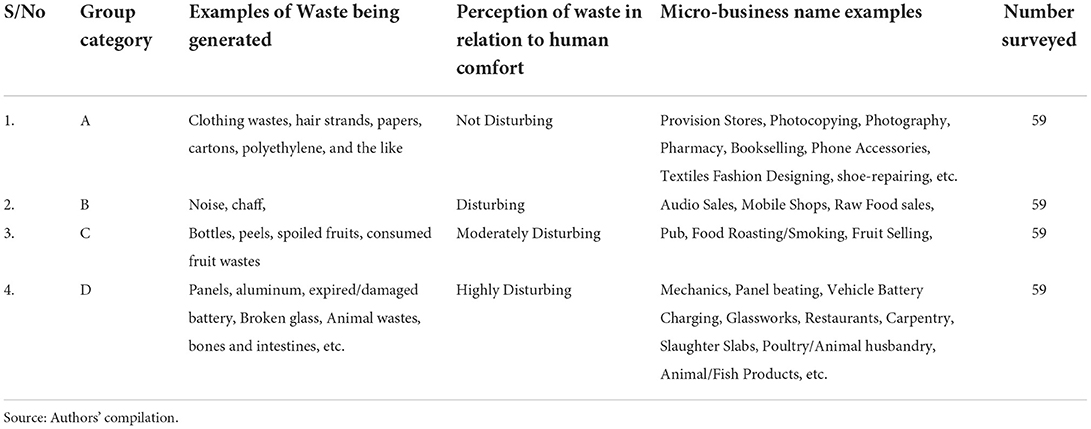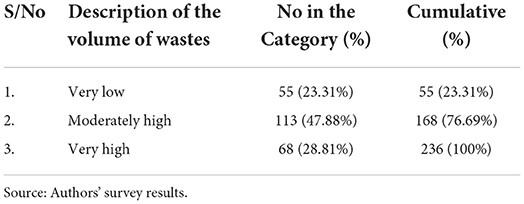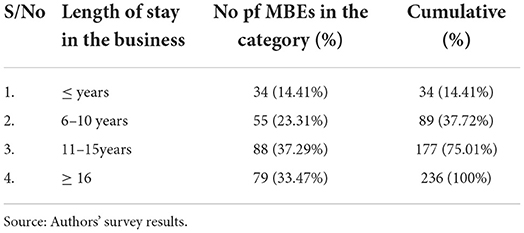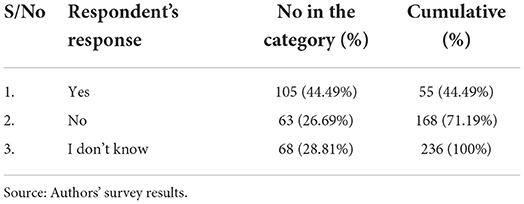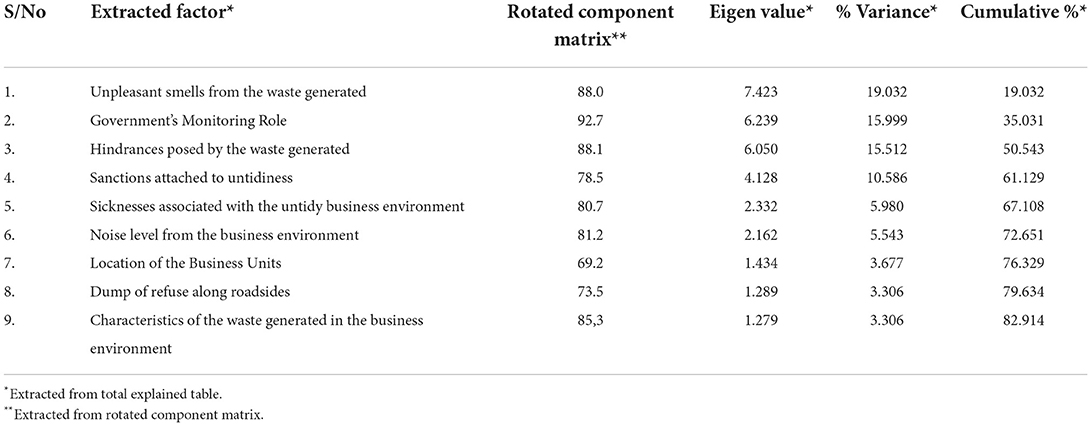- 1Environmental Management and Crop Production Unit, College of Agriculture, Engineering and Science, Bowen University, Iwo, Nigeria
- 2Business Administration Programme, College of Management and Social Science, Bowen University, Iwo, Nigeria
- 3Department of Geography, Obafemi Awolowo University, Ile-Ife, Nigeria
Sustainable environmental quality is a prerequisite to a sustainable human livelihood. This work evaluated the impacts of micro-business enterprises (MBEs) on the quality of the urban environment, with Iwo, Nigeria, as a case study. A survey of the identified micro-businesses across the city brought about four categorizations which were based on the kinds of waste being generated. Fifty-nine business units were randomly selected from each category, thus, making a total of 236 for the survey to generate the required data. The data were subjected to both descriptive and inferential statistics. The results showed that 75.01 of the respondents have spent between 11 and 15 years in their respective enterprises while the volume of waste being generated by 76.69% of the MBEs fell in the “moderately high” category and 71.19% did not associate any illness to the waste generated by the MBEs. The results of Factor Analysis showed that nine factors explained 82.914% of how MBEs have impacted the quality of the urban environment. The results further showed that bad odors from the waste generated by the MBEs topped the variables with the highest predictive power (19.032%) while the waste characteristics offer the least explanation (3.279%). However, the 60.96 percent bulk of the 100% explanation was made by the top three variables namely bad odors from the waste generated by the MBEs, the government's monitoring role, and the hindrances posed by the wastes. The work, therefore, concludes that the MBEs could be more beneficial to human livelihood and the physical environment rather than being detrimental if both the entrepreneurs (the citizens) and the government adhere to their respective responsibilities. Relevant authorities in Nigeria should initiate policies that are capable of stimulating the growth of entrepreneurial activities with effective regulation to curtail urban degradation for improved livelihood. It is suggested that further studies on the compliance of MBE operators to the established governing rules be carried out.
Introduction
The livelihood and the survival of human beings depend on three basic necessities of life, namely, food, shelter, and clothing, which are derivable from the human ecosystem. The concern about environmental quality as embedded in the concept of “environmental sustainability” has become increasingly in vogue (Frankel, 2009; Ogunbode and Asifat, 2021; Ogunbode et al., 2021). The procurement or acquisition of these necessities by human beings involves their continuous efforts in time and space within their natural environment (Frankel, 2009). Any disruption or denial toward achieving these targets will undoubtedly impinge on the survival of human beings on the earth, as a result of the diversity in the distribution of natural resources. Ibimilua (2011), in corroborating this fact, revealed that human desires for their livelihood cannot be carried out without its consequences on the environment. However, they reiterated that such desires should be anchored within the ambit of conservation, preservation, rehabilitation, and sustainability. Thus, the day-in and day-out struggles of human beings are inevitable to ensure their survival through their engagement in various economic activities. Human beings engage in various activities on daily basis to ensure survival such as primary, secondary, and tertiary activities. According to Ibimilua (2011) and Zhang et al. (2022), such human activities are principally determined by the attributes of one's immediate environment, especially in primary activities. The implication of this observation is that what human beings engage in to ensure their survival contributes to the quality of the environment to which they also belong. In general, all human activities exert various degrees of influence on the status of the natural environment, which most of the time, are often detrimental to the ecological balance. Thus, in line with the view of Jena and Behera (2017), it can therefore be concluded that human beings significantly distress the environment through the actions of organizations for their benefit. For instance, the erection of buildings and setting up of industries, road construction, and channelization, among others, exacerbate modifications of different kinds to the human environment. Furthermore, buying and selling activities, wholesaling and retailing businesses, and the like, are all needful to ensure human accessibility to their needs at any point in time and space. Micro Business Enterprises (MBEs) are well-known in developing countries and found in practice among the citizenry in developing countries. The reasons for this feature are not far-fetched as most of these countries are poverty-ridden and do not have the required capital to embark on bigger industrial set-ups (Humphrey, 2003; Keskin et al., 2010; Ibimilua, 2011; Grater et al., 2017). Also, in light of this scenario, MBEs have become important means of survival for a large proportion of people in many of these developing countries like Nigeria, Ghana, Kenya, and so on. The establishment of MBEs has gained substantial support from the government at various levels, international and local Non-Governmental Organizations (NGOs), and corporate and religious organizations. Furthermore, MBEs have provided employment to most citizens in various countries because they require less capital for their establishment (Muriithi, 2017; Kongolo, 2019; Erdin and Ozkaya, 2020; Pulka and Gawuna, 2022). However, all these human activities, despite their significance to human survival and comfort, have been observed to contribute immensely to the quality of the human environment, to the extent that if their activities are not properly checked or controlled, according to Indama and Abdurahim-Salain (2019) and Olowoyo et al. (2020), their impact on the human environment may jeopardize human comfort and sustainability on the planet. For instance, most of these MBEs have been found to contribute in various degrees to noise pollution, traffic obstruction, water contamination, and land degradation. They generate waste which most often is indiscriminately disposed of in the environment (Olowoyo et al., 2020), apart from nuisances caused by the noise created by the cause of their various operations (Sofer et al., 2012).
Moving on, several environmental quality indexes (EQIs) have been proposed by different scholars but the problem with most of these EQIs is that they can be complex and specific to where they are derived from. Thus, EQIs cannot be generalized for all locations on Earth. Such EQIs have helped in the derivation of various theories used in explaining the quality of the natural and human environments. Lobdell et al. (2011) and Environmental Protection Agency (EPA) have both generated an EQI for respective places of study using data from four environmental components, namely, the water, soil, air, and sociodemographic domains. Lobdell et al. (2011) added the built environment domain to the list of components from which to derive the EQI. The data from these domains were computed and the PCA statistical method was applied by EPA to derive its EQI. The significance of EQIs, as highlighted by Lobdell et al. (2011), are: (i) To represent environmental quality in research designed to assess the relationship between environmental quality (EQ) and human health outcomes; (ii) it serves as a variable to account for surrounding conditions for researchers interested in a specific environmental exposure (e.g., exposure to pesticides) and human health outcomes (e.g., cancer); (iii) an EQI holds promise for improving environmental estimation in public health because it describes the surrounding county-level conditions to which residents are exposed; (iv) an EQI enhances comparisons at regional, local or international levels; and (v) To detect the important environmental domain/s that contribute/s to an individual place's EQ.
In Nigeria and Iwo, in particular, being an agrarian economy, the prevalence of MBEs cannot be over-emphasized. Most inhabitants engage solely in various economic activities as a means of their livelihood. Further, other workers such as civil servants and the like are involved in menial businesses to complement the income from fixed sources. The contributions of the operations of MBEs to the quality of the physical urban environment are yet to be quantified in Iwo. These activities have resulted in various discomforts and menaces including impeding free traffic flows, noise pollution through their use of loud music to attract their clients and/or customers, unpleasant odors through refuse dumps, even along the road, throwing waste water on the road, loss of the beauty of the town, and destruction of public utilities like roads (Sofer et al., 2012). Given these features, this study aimed at evaluating how MBE operations have impacted the quality of the environment in Iwo, Nigeria, to identify the variables and work toward a better urban environment. The specific objectives are 3-fold; (i) identification of variables associated with activities of the MBEs that have contributed to the quality of the urban environment; (ii) quantification of the contributions of the MBEs' operations to the quality of the environment in the town; (iii) expression of the relationship between the predictive variables and EQ, to forecast the status in time and space.
Method of study
Study area
This research was carried out in Iwo (Figure 1), the headquarters of Iwo Local Government Area of Osun State, Nigeria. Iwo, located in Osun State in southwestern Nigeria, has an area of 245 km2 with a population of 191,348, according to the 2006 population census. It is located on the coordinate axis of 7°38'N and 4°11'E. The prevailing climatic condition is tropical with ~8 months of rainfall (March to October) and the dry season is ~4 months (November to February). Iwo is an agrarian economy depending on primary activities. Some inhabitants also engage in micro-business enterprises (MBEs) as major sources of livelihood while some combine both activities for life sustainability. Primary activities engaged in include crop farming, animal husbandry, and lumbering, among others, while business enterprises in the town are found everywhere on the streets, nooks, and crannies. Their footprints can be noticed in the Palace area, Odo-Ori Market area, Oluwo Market Area, Idi-Oke Area, Oja-Ale Area, Oyo Road to Kaara Junction, Osogbo Park Junction Area, and Araromi Road, to mention but a few. Among the MBEs in Iwo include daily need provision shops, shoe making, foodstuffs, farm products shops, clay pot shops, building materials shops, wears shops, canteens, communication materials shops, used tires shops, vulcanizing outlets, liquor sales, electronic shops, animal husbandry, and a host of others. All these MBEs are either found as detachments to residential buildings and/or as separate shops. However, to make sales and survive in their businesses, these entrepreneurs engage in various activities. These include advertising by playing music, walking about with their products, approaching their respective clients/customers, displaying their products outside their shops/stores, and deliberately blocking parking spaces along the road so that vehicles do not park in front of their shops, among others. The current influx of people from neighboring communities into Iwo has contributed to the proliferation of various kinds of MBEs arbitrarily located in the town, a scenario that is threatening the urban quality and calls for research such as this.
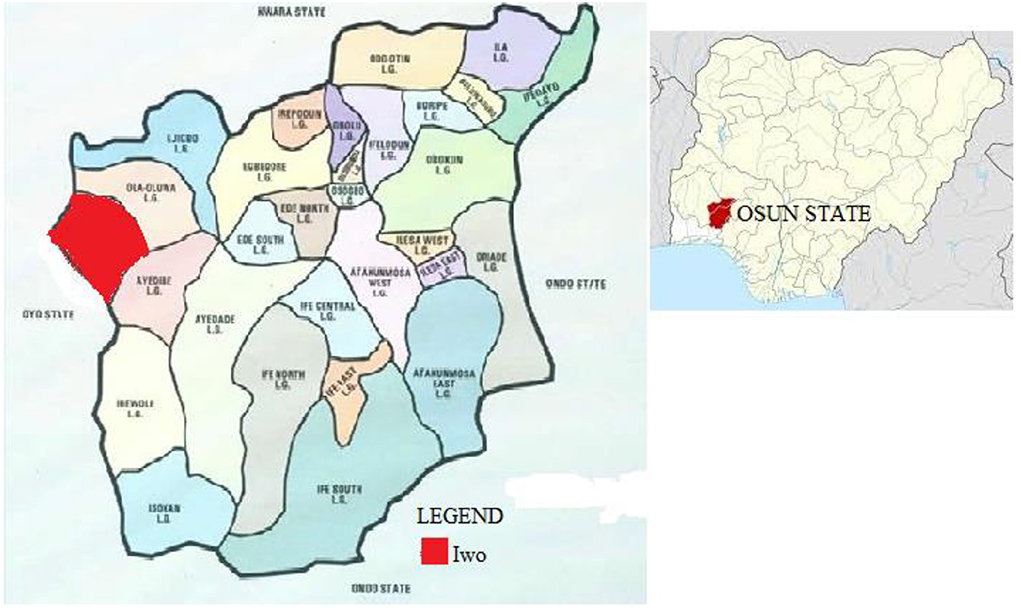
Figure 1. Map of Osun State showing the location of Iwo (Inset: Map of Nigeria showing the location of Osun State).
Data collection
The data used for this study were generated through the administration of a questionnaire among the operators of different MBEs. The MBEs include professionals such as motor mechanics, welders, hairdressers/barber saloons, tailors, provision stores, food items, fast food stands (e.g, akara shops, moinmoin stands, etc.), textile materials, cafeterias, carwash, cement shops, and agricultural products sales points, among others. These MBEs were categorized into four categories based on the characteristics of the wastes being generated. The categories are; (i) those businesses that generate papers, nylons, tissues, cartons, audio shops, and the like; (ii) those businesses that generate remnants of food items, peels, chaff, and the like; (iii) those businesses that generate wood shavings, air strands, textile materials, leathers, and so on; and (iv) those businesses that generate toxic wastes, liquid wastes which may be wastewater and spent engine oils, iron and aluminum scraps, plastic bottles, and the like. Fifty-nine respondents were randomly selected from each category of the MBEs identified for the investigation. Thus, 236 questionnaires were administered and retrieved in the survey which was conducted within the working hours of the day. Observations on the physical environment were made alongside the survey to complement the information supplied by the respondents.
Data analysis
The data were subjected to statistical analysis, both descriptive and inferential statistics. The descriptive analysis includes the use of the mean, percentages, and tabulation of the data. A multivariate statistic was used to obtain the dominant variables that influence the contributions of the micro-businesses operations on the quality of the urban physical environment in the study area.
Results and discussion
Descriptive analysis of the data
Grouping and characteristics of the MBEs used in the study
Table 1 shows the characteristics and the grouping of the MBEs involved in the survey. The grouping into “Not Disturbing”, “Disturbing”, “Moderately Disturbing”, and “Highly Disturbing” is based on the potential impact of wastes generated by the MBEs identified on human comfort.
The volume of waste generated by the MBEs
Table 2 shows the description of the volume of waste generated by the MBEs in the study area. The Table shows that those in the “Very Low” volume category were the least with 23.31% while those in the category of “Moderately High” and “Very High” were 47.88 and 28.81%, respectively. Thus, this indicates that most MBEs in the study area generate either a “Moderately High” or “Very Low” volume of waste with 76.69% in that category. It is expected that the higher the volume the MBEs generated, the higher the burden of management, also corroborated by Brotosusilo et al. (2022).
Respondents' views on the length of stay in their respective businesses
Table 3 shows that 14.41% of the respondents have spent <5 years in their respective businesses while 23.31% spent 6–10 years, 37.29% 11–15 years, and 33.47% spent >6 years. The number of years will influence the volume of waste being generated given their long establishment in the business (Abdel-Shafy et al., 2018).
Respondents' views on cases of waste-associated sicknesses in their business areas
Table 4 revealed that 44.49% of the respondents are aware that there had been cases of sickness in their business environment while 26.69% declared no knowledge of it and 28.81% claimed not to know anything about it. This situation needs to be checked through proper education on the consequences of an untidy business environment.
Environmental quality and the contributions of micro-business operations in Iwo
The data were subjected to a Kaiser-Mayer Olkin (KMO) measure of sampling adequacy and Bartlett's test of sphericity (BTS) to ascertain the factorability of the data, as shown in Table 5. The results of the tests showed a KMO of 0.560 and BTS of 0.741 with a significance value of p ≤ 0.005 which implies that the data is adequate and factorable and so could undergo factor analysis (FA). The eigenvalue was set at a minimum of 1.000.
The results presented in Table 6 show the extracted variables and their respective rotated component matrix (RCM), eigenvalue, proportion of variance in the explanation, and the cumulative values against each variable.
The results of the FA showed that nine variables were extracted out of the 39 variables analyzed. The nine variables explain 82.914% of the total variance in the contribution of the MBEs to the quality of the physical environment of Iwo township. In addition, the results revealed that the top three variables extracted dominated the explanation for the variance in the contribution of MBEs to the quality status of the urban environment weighing 50.543% of the entire 82.914% (that is, 60.96% of all while the remaining six variables explained 39.04% of the variation). The factors are; (i) unpleasant smells from the waste; (ii) the government's monitoring role and; (iii) hindrances posed by the wastes generated in the business area. The predictive strength of the nine (9) variables extracted is detailed below.
Unpleasant odor from the waste generated
Table 1 revealed that the unpleasant odor from the wastes often generated by the MBEs tops the variables extracted by the FA. It explains 19.032% of the total variance of 82.914% of the contributions of the MBEs in Iwo township with the highest eigenvalue of 7.423 and an RCM of 88.0 in the array of other variables. Thus, the operators of the MBEs are conscious of the waste generated in their environment and the need to remediate the situation to enjoy a good quality environment. This finding corroborated the findings of De Feo et al. (2013) and Wen et al. (2022), where it was recommended that adequate compensation should be granted to those that are located at the dump site area in view of the health implication of the odor from the wastes.
Government's monitoring role
Table 2 also identified the monitoring role of the government as one of the determinants of the contributions of the MBEs to the quality of the physical environment in Iwo. In support of this observation, James and Benon (2016), having evaluated the significance of the monitoring role of the government, recommended that the role should be institutionalized, funded, and identified properly to mediate policy process, planning, and service delivery. Lv et al. (2021), in corroborating this observation, revealed the significance of environmental regulation in enhancing innovation output and green technology innovation, and in curtailing urban degradation, as noticed by Sarwar and Alsaggaf (2019).
Hindrances posed by the waste generated
The results of the FA, as presented in Table 2, showed that the hindrances posed by the waste generated by the MBEs predict the contributions of the operators and the operations of such enterprises by 15.512% with an eigenvalue of 6.050 and an RCM of 88.1. This factor, which came third of the factors extracted, implies that various hindrances such as traffic flow obstruction, space occupation, and the spread of diseases, among others, could engender the contribution of the MBEs to the quality of the environment. In light of this, Douti et al. (2017) noted that the awareness of the public on the management of waste and non-inclusion in the management system should be worked on to ensure the hindrances caused by the waste in urban centers are controlled.
Sanctions against erring entrepreneurs
Another variable extracted by the FA is the sanctions attached to the defaulting business operators, having explained 10.586% of the entire variances with an eigenvalue of 4.128 and an RCM of 78.5, as presented in Table 2. The respondents noted that the operators of the MBEs in the study area are sensitive to the various sanctions often meted out to the erring entrepreneur on the issue of an unwholesome attitude toward attaining sustainable quality of the environment. Thus, every effort is made to ensure compliance with the rules. Roshan et al. (2015) and Fu et al. (2020), in support of this, submitted that sanctions of various forms have the power to curtail unwholesome attitudes of the entrepreneurs (citizens) that engage in violating rules and regulations guiding their business operations.
Waste-induced sicknesses
Table 2 shows the awareness and experiences of the MBEs in the study area of the sickness often induced by the poor quality of the environment and explains the impact of the MBE operators on this variable. This variable explains 5.980% of the total variance with an eigenvalue of 2.372 and an RCM of 80.7. In corroborating this finding, Mutizwa and Makochekanwa (2015) revealed that it is important for the government in their study area to strengthen environmental regulations that will ensure people's access to good quality environmental resources such as water and air, among others.
Control of noise levels
Another variable extracted in the factor analysis is the measure put in place to control the level of noise created by the MBEs in the study area, as shown in Table 2. The variable explains 5.543% of the total explanation with an eigenvalue of 2.162 and an RCM of 81.2, among the 39 variables analyzed. The noise generated by the MBEs could be from audio shops through their advertisement to attract their potential clients, through the use of public address systems for mobile advertisements, and so on. All of these could engender the degradation of the environmental quality. The Department of Environment Food Rural Affairs (2013), in 2014, lamented the unquantifiable impact of environmental noise on human comfort, health, and productivity and so recommended, among others, the monetization of further research on the productivity impact of noise for a better urban environmental quality.
Location choice of business entrepreneurs
The analysis shown in Table 2 also listed the location of business units as one of the variables that predict the impact of MBEs on the quality of the urban environment. The factor offers 3.677% of the total explanation with an eigenvalue of 1.434 and an RCM of 69.2 in the array of the 39 factors analyzed. This is an indication that when MBEs are centrally located may be environmentally degrading. This is because relevant decisions regarding planning and control can be centrally carried out by the appropriate authority. Such activity may prove cumbersome where MBEs are indiscriminately located. This finding was also in line with the observation of Chin (2020).
Dump of waste on roadsides
The analysis identified the dumping of waste along roadsides as another variable that explains the contribution of the MBEs to the quality of the urban environment. A proportion of 3.306% of the total explanation was predicted by the factor with an eigenvalue of 1.289 and an RCM of 73.5, thus indicating that the MBEs could encourage the dumping of waste along the roadsides, an action that could jeopardize the quality of the urban environment. Butu et al. (2013) corroborated this finding in their work in Nasarawa State, Nigeria, where it was discovered that such waste is susceptible to being blown around by wind action, blocking drainages, and causing filthiness, among others. Thus, recommending the re-orientation of people, instituting relevant environmental laws, and provision of facilities for proper waste dumps could alleviate this issue.
Characteristics of the waste generated
Last on the list of the extracted factors is the characteristics of the waste generated by the MBEs, as shown in Table 2. It predicts 3.279% of the total explanation of the impact of the MBEs on the quality of the physical environment of the Iwo township. Its eigenvalue and RCM are 1.279 and 85.3, respectively. The inclusion of the characteristics of waste implies that the quality of the environment will be determined by whether the waste is either toxic or non-toxic. This supports the report of Tchounwou et al. (2015).
Relationship between EQ and the extracted factors
Thirty-nine (39) variables, that were presumed to explain the impact of MBEs on the quality of the environment, were reduced by an FA to nine (9).
Further examination of the extracted factors showed that six of them are closely waste-related or associated. The seven factors are; Unpleasant odor from the waste (F1), Hindrances posed by the waste (F3), sicknesses induced by indiscriminate refuse dumping (F5), Control of noise levels (F6), Dumping of refuse on roadsides (F8) and characteristics of the waste generated (F9). The remaining three namely; the government's monitoring role (F2), Sanctions against erring entrepreneurs (F4), and Location choice of the entrepreneurs (F7), are human-associated. Generally, the relation between Environmental Quality (Eq) and the variables can be expressed as given below:
where f stands for function F1 – F9 are as defined above,
After further scrutiny, the nine factors were reduced to two categories namely waste-associated and human-associated. The waste-associated factors are F1, F3, F5, F6, F7, F8, and F9, while the three human-associated are F2, F4, and F7. It could, therefore, be adjudged that the major determinants that explain the impact of MBEs on the quality of the urban environment are mainly waste-associated and human-associated. Thus, the expression (1) can be rewritten as;
The deduction from the in-depth examination of the FA results is that impact of the MBEs on the quality of the environment is human-dependent. Thus, it can therefore be submitted that if the human efforts (Government and the entrepreneurs) can be adequately directed and rightly channeled in relation to the operations of the MBEs, then the challenges that the MBEs could pose to the quality of the urban environment can be effectively overcome and so made more beneficial. Cao et al. (2021), Khan et al. (2021), and Lv et al. (2021) similarly reported that financial enterprises should be promoted because they are drivers of economic growth and a green environment. Sarwar and Alsaggaf (2021), also corroborated the findings as they submitted that sound governance and regulation roles of the authorities are powerful tools for minimizing carbon emissions in urban centers.
Conclusion and recommendation
An investigation into the factors that explain the impact of MBEs on the quality of the environment with Iwo, Nigeria, as a case study, was carried out. The analysis revealed that nine variables, out of 39 variables that were identified using multivariate statistics, largely explain 82.914% of the total variance. These variables are: (i) Unpleasant smells from the waste generated; (ii) The government's role in monitoring; (iii) Hindrances posed by the waste generated; (iv) Attached sanctions for untidiness; (v) Sicknesses induced by the untidiness; (vi) Control of Noise Level; (vii) Location Choice of Business Entrepreneurs; (viii) Waste dumps along roadsides; and (ix) Characteristics of the waste generated. However, the first three variables outweighed the others in predictability strength, having explained 60.96 percent of the explanation, while the remaining six predicted 39.04% of the impacts of MBEs on the urban environment. The implication of this result is that adequate management of the waste generated by these MBEs, with the support of the government's monitoring responsibility, is expedient in the contributions of the MBEs to the quality of the urban environment. This work, therefore, suggests that the benefits of the MBEs to human livelihood can be maximized rather than being a detriment to the quality of the environment. However, all stakeholders, especially the entrepreneurs and the government, through its relevant agencies, are to adhere to their respective responsibilities. The relevant authorities in Nigeria should initiate policies that are capable of stimulating the growth of entrepreneurial activities with effective regulation to curtail urban degradation for improved livelihood. It is suggested that further studies on the compliance of MBE operators to the established governing rules be carried out.
Data availability statement
The original contributions presented in the study are included in the article/supplementary material, further inquiries can be directed to the corresponding author/s.
Author contributions
TO: designed the project, supervised the collection of data, analysis, and proofread the manuscript. OO: collection of data, analysis of the data, and edited and proofread. VO: collection of data, analysis of data, and proof read the manuscript. All authors contributed to the article and approved the submitted version.
Conflict of interest
The authors declare that the research was conducted in the absence of any commercial or financial relationships that could be construed as a potential conflict of interest.
Publisher's note
All claims expressed in this article are solely those of the authors and do not necessarily represent those of their affiliated organizations, or those of the publisher, the editors and the reviewers. Any product that may be evaluated in this article, or claim that may be made by its manufacturer, is not guaranteed or endorsed by the publisher.
References
Abdel-Shafy, H. I., Mona, A., and Mansour, S. M. (2018). Solid waste issue: sources, composition, disposal, recycling, and valorization. Egypt. J. Petrol. 27, 1275–1290. doi: 10.1016/j.ejpe.2018.07.003
Brotosusilo, A., Utari, N. D., Firdaus, A., and Velentina, R. A. (2022). Community empowerment of waste management in the urban environment: more attention on waste issues through formal and informal educations. Global J. Environ. Sci. Manage. 8, 209–224.
Butu, A. W., Ageda, B. R., and Bichi, A. A. (2013). Environmental impacts of roadside disposal of municipal solid wastes in Karu, Nasarawa State, Nigeria, Int. J. Environ. Pollut. Res. 1, 1–19.
Cao, J., Law, S. H., Samad, A. R. B. A., Norhidayal, W., and Mohamad, B. W. (2021). Impact of financial development and technological innovation on the volatility of green growth—evidence from China. Environ. Sci. Pollut. Res. 28, 48053–48069. doi: 10.1007/s11356-021-13828-3
Chin, J. T. (2020). Location choice of new business establishments: understanding the local context and neighborhood conditions in the United States. Sustainability 12, 501. doi: 10.3390/su12020501
De Feo, G., De Gisi, S., and Williams, I. D. (2013). Public perception of odour and environmental pollution attributed to MSW treatment and disposal facilities: a case study. Waste Manag. 33:974–87. doi: 10.1016/j.wasman.2012.12.016
Department of Environment Food and Rural Affairs (2013). Environmental Noise: Valuing Impacts on Sleep, Disturbance, Annoyance, Hypertension, Productivity and Quiet. A Report informed by the Interdepartmental Group on Costs and Benefits Noise Subject Group. P61. Available online at: www.gov.uk/defra (accessed on August 17, 2022).
Douti, N., Abanyie, S., Ampofo, S., and Nyarko, S. (2017). Solid waste management challenges in urban areas of Ghana: a case study of Bawku municipality. Int. J. Geosci. 8, 494–513. doi: 10.4236/ijg.2017.84026
Erdin, C., and Ozkaya, G. (2020). Contribution of small and medium enterprises to economic development and quality of life in Turkey. Heliyon 6, e03215. doi: 10.1016/j.heliyon.2020.e03215
Frankel, J. A. (2009). Environmental Effects of International Trade. Stockholm: Sweden's Globalization Council.
Fu, Q., Chen, Y. E., Jang, C., and Chang, C. (2020). The impact of international sanctions on environmental performance. Sci. Total Environ. 745, 141007. doi: 10.1016/j.scitotenv.2020.141007
Grater, S., Parry, A., and Viviers, W. (2017). Realizing the Potential of Services MBEs in Developing Economies. Inclusive Economic Transformation: International Centre for Trade and Sustainable Development. Issue Paper.
Humphrey, J. (2003). Opportunities for MBEs in Developing Countries to Upgrade in a Global Economy. SEED Working Paper No. 43. Series on Upgrading in Small Enterprises Clusters and global value chains. Geneva: International Labour Organization, 38.
Ibimilua, F. O. (2011). Linkages between poverty and environmental degradation. Afr. Res. Rev. 5, 475–484. doi: 10.4314/afrrev.v5i1.64545
Indama, A. C., and Abdurahim-Salain, H. (2019). Perceptions and practices among Barangay micro-businesses: inputs to local solid waste management policy. Int. J. Multidiscipl. Res. Publ. 2, 20–23.
James, O., and Benon, C. B. (2016). Measuring the effective role of public sector monitoring and evaluation in promoting good governance in Uganda: implications from the Ministry of Local Government. Africas Public Serv. Deliv. Perform. Rev. 4, 410. doi: 10.4102/apsdpr.v4i3.122
Jena, L. K., and Behera, B. (2017). Pork consumer preferences in Swaziland. Int. J. Dev. Sustain. 6, 561–574.
Keskin, H., Senturk, C., Sungur, D., and Kiriş, H.M. (2010). “The importance of MBEs in developing economies,” in 2nd International Symposium on Sustainable Development (Sarajevo), 183–192.
Khan, A., Chenggang, Y., Hussain, J., and Kui, Z. (2021). Impact of technological innovation, financial development and foreign direct investment on renewable energy, non-renewable energy and the environment in belt & Road Initiative countries. Renew. Energy 171, 479–491. doi: 10.1016/j.renene.2021.02.075
Kongolo, M. (2019). Job creation versus job shedding and the role of MBEs in Economic Development. Global J. Bus. Manag. 13, 1–18.
Lobdell, D. T., Jagai, J. S., Rappazzo, K., and Messer, L. C. (2011). Data sources for an environmental quality index: availability, quality, and utility. Am. J. Public Health 101(Suppl. 1), S277–S285. doi: 10.2105/AJPH.2011.300184
Lv, C., Shao, C., and Lee, C. C. (2021). Green technology innovation and financial development: do environmental regulation and innovation output matter?, Energy Econ. 98. doi: 10.1016/j.eneco.2021.105237
Muriithi, S. M. (2017). African small and medium enterprises (MBEs contributions, challenges and solutions. Eur. J. Res. Reflect. Manag. Sci. 5, 36–48.
Mutizwa, A., and Makochekanwa, A. (2015). Impact of environmental quality on health status: a study of 12 Southern African Development Community (SADC). countries between 2000 and 2008. Botswana J. Econ. 13, 87–111.
Ogunbode, T. O., and Asifat, J. T. (2021). Sustainability and challenges of climate change mitigation through urban reforestation - a review. J. For. Environ. Sci. 37, 1–13. doi: 10.7747/JFES.2021.37.1.1
Ogunbode, T. O., Omotayo, O. E., Olatubi, I. V., Ogungbile, P. O., Asifat, J. T., and Oyebamiji, V. O. (2021). Challenges of degradation in the tropical environment: causes, footprints and remedies. Aswan Univ. J. Environ. Stud. 2, 218–239. doi: 10.21608/aujes.2021.89948.1035
Olowoyo, J. O., Mpagane, L., and Nyathi, S. (2020). Nature of waste and disposal practices among different business holders around industrial area of Rosslyn, Pretoria, South Africa. Nat. Environ. Pollut. Technol. 19, 1491–1497. doi: 10.46488/NEPT.2020.v19i04.015
Pulka, B. M., and Gawuna, M. S. (2022). Contributions of MBEs to employment, gross domestic product, economic growth and development. Jalingo J. Soc. Manag. Sci. 4, 1–18.
Roshan, N. A., Mehrbod, S., and Abbassi, M. (2015). “The impacts of economic sanctions on sustainable development: focusing on Labour,” in Cumhuriyet Üniversitesi Fen Fakültesi Fen Bilimleri Dergisi (CFD), Cilt:36, No: 3 Ozel Sayi (2015). Special Issue: The Second National Conference on Applied Research in Science and Technology.
Sarwar, S., and Alsaggaf, M. I. (2019). Role of urbanization and urban income in carbon emission: regional analysis of China. Appl. Ecol. Environ. Res. 17, 10303–10311. doi: 10.15666/aeer/1705_1030310311
Sarwar, S., and Alsaggaf, M. I. (2021). The role of governance indicators to minimize the carbon emission: a study of Saudi Arabia. Manag. Environ. Qual. 32, 970–988. doi: 10.1108/MEQ-11-2020-0275
Sofer, M., Potcher, O., Gnaim, N., and Gnaim, J. M. (2012). Environmental nuisances from industrial activities in residential areas of Arab municipalities in Israel. Appl. Geograp. 35, 353–362 doi: 10.1016/j.apgeog.2012.08.005
Tchounwou, P. B., Yedjou, C. G., Patlolla, A. K., and Sutton, D. J. (2015). Heavy metal toxicity and the environment. Exp Suppl. 101, 133–164. doi: 10.1007/978-3-7643-8340-4_6
Wen, F., Yujie, H., Yimeng, D., Guangxia, Q., Yanjun, L., and Jun, B. (2022). Health risks of odorous compounds during the whole process of municipal solid waste collection and treatment in China. Environ. Int. 158, 106951. doi: 10.1016/j.envint.2021.106951
Keywords: environmental quality (EQ), micro-business enterprises, urban center, factor analysis, waste management
Citation: Ogunbode TO, Oyelude O and Oyebamiji VO (2022) Evaluation of the impacts of micro-business operations on the quality of urban environment: A case study of Iwo, Southwestern Nigeria. Front. Sustain. Cities 4:1027450. doi: 10.3389/frsc.2022.1027450
Received: 25 August 2022; Accepted: 20 September 2022;
Published: 28 October 2022.
Edited by:
Qing Wang, Shandong University, ChinaReviewed by:
Xiaodong Yang, Xinjiang University, ChinaSuleman Sarwar, Jeddah University, Saudi Arabia
Copyright © 2022 Ogunbode, Oyelude and Oyebamiji. This is an open-access article distributed under the terms of the Creative Commons Attribution License (CC BY). The use, distribution or reproduction in other forums is permitted, provided the original author(s) and the copyright owner(s) are credited and that the original publication in this journal is cited, in accordance with accepted academic practice. No use, distribution or reproduction is permitted which does not comply with these terms.
*Correspondence: Timothy O. Ogunbode, dGltb3RoeS5vZ3VuYm9kZUBib3dlbi5lZHUubmc=
 Timothy O. Ogunbode
Timothy O. Ogunbode Opeyemi Oyelude2
Opeyemi Oyelude2